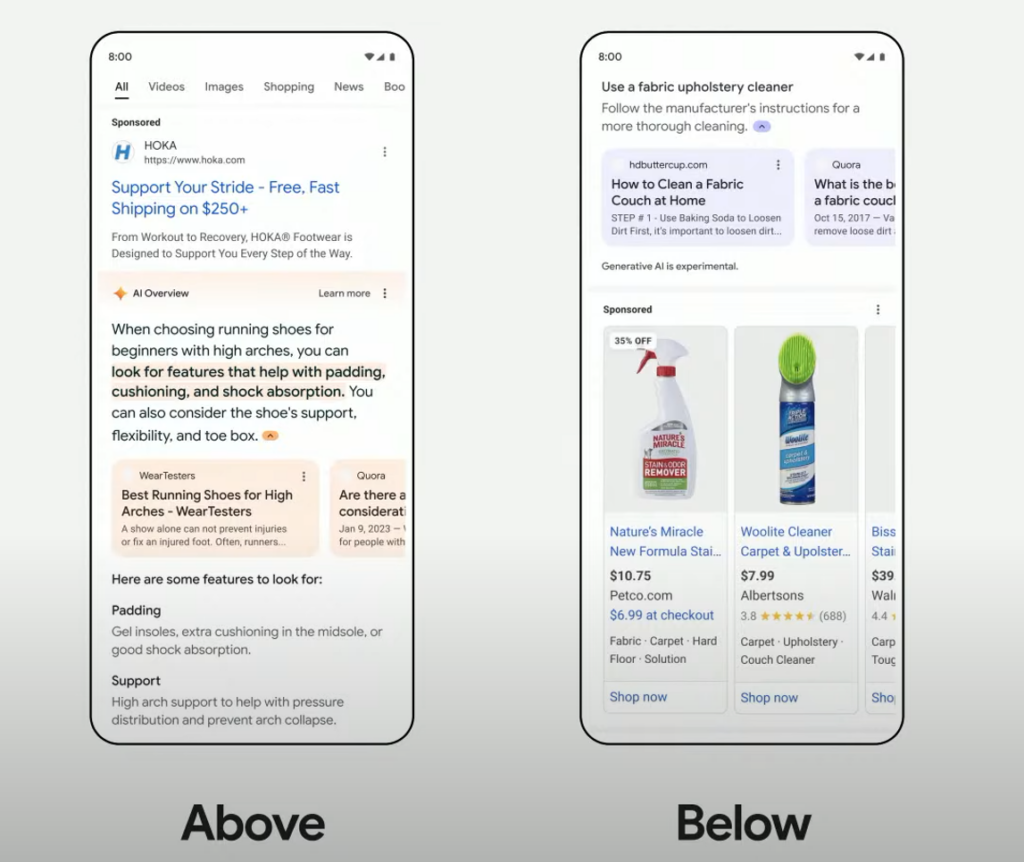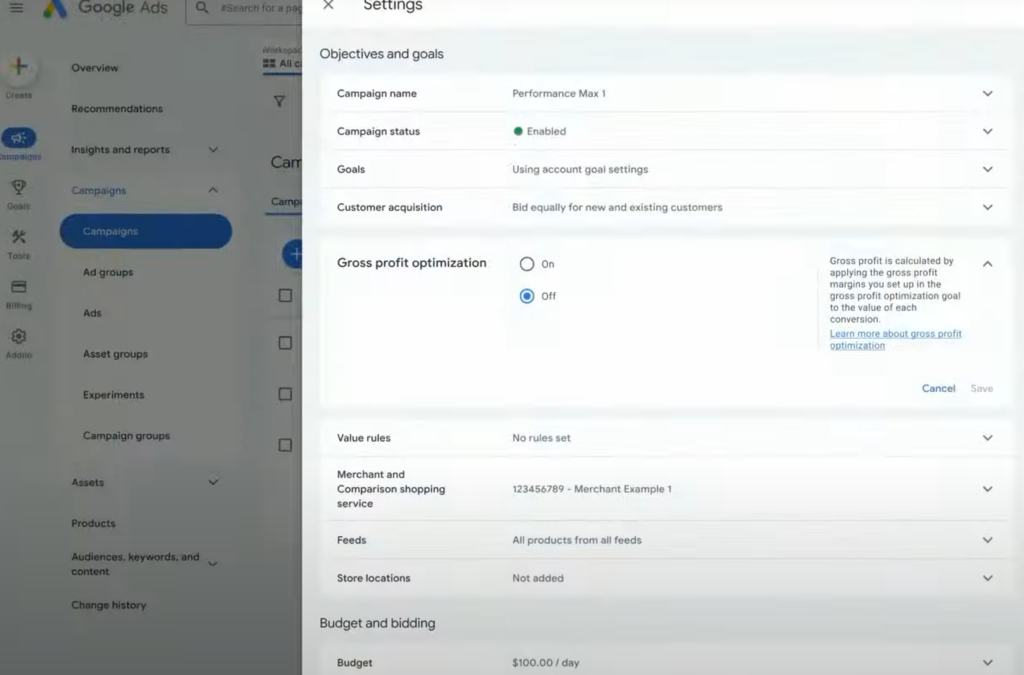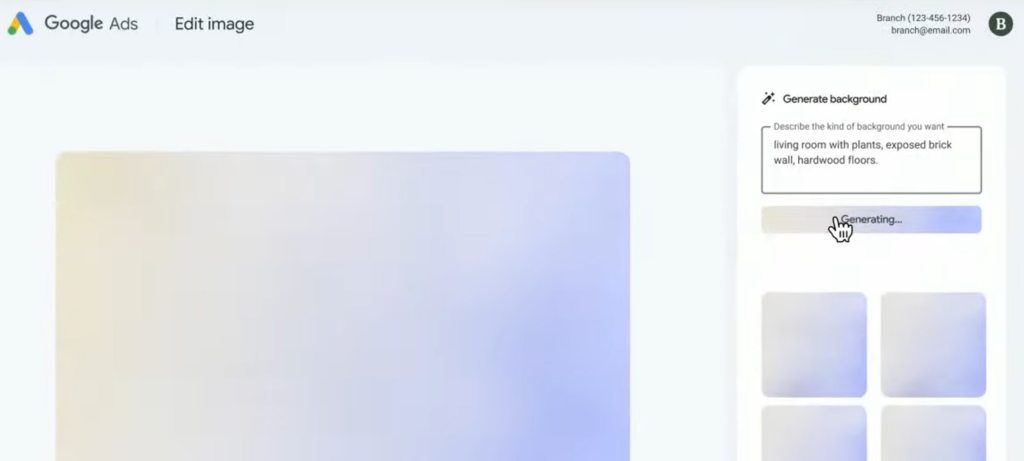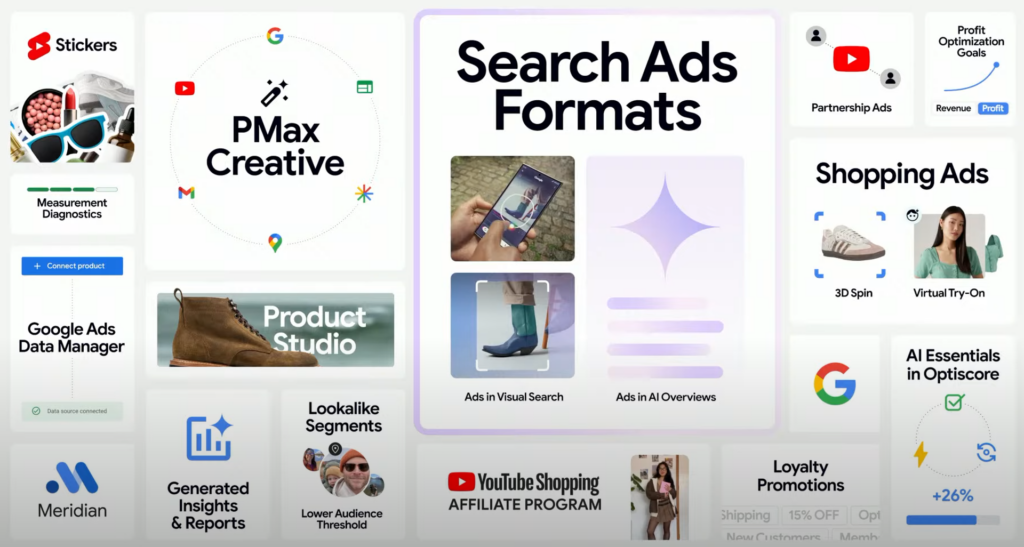Google Marketing Live 2024 is over and to my surprise there was less general AI talk than I had assumed. To be honest, I still kept an AI counter and the word AI was used 79 times (if im not mistaken). Nevertheless, it has to be said that Google Marketing Live 2024 was packed with over 30+ new features, product announcements and exciting ideas, away from the classic “we want to increase your advertising spend”.
Here’s a recap of GML 2024 with everything you need to know about the current Google Marketing Roadmap.
Philipp Schindler from Google started of by reflecting on the event’s history and evolution, highlighting its importance in connecting customers with Google’s product and partner teams. The vision was set with the headline “a new era of AI” and the core question “what can AI do for me and how can I implement it… as fast as possible?”
Schindler continued by showing 5 core Trends Google has found to be good to build their AI products on.
1. The “Exactly What I Want” Search
Users increasingly seek precise and specific information. Generative AI is stepping up to meet this demand by enabling highly detailed searches. The trend shows a significant rise in queries with five or more words, indicating users’ desire for specific answers. This development allows businesses to match their offerings more accurately with user intent, driving better engagement and satisfaction.

Googles AI solutions will be able to show better results for highly specific searches. Note that this will only work if those AI Overviews are actually working. Looking at the SEO world right now, AI Overviews are a complete mess and users are not finding what they are looking for. Google still has a long way to go here.
2. Complex Search Made Easy
Planning and executing complex searches can be daunting, but AI is simplifying the process. Google’s advanced AI can now handle multifaceted queries seamlessly, providing users with organized and intelligent results. For instance, planning a family day out in a new city with detailed recommendations for activities and nearby amenities is now easier than ever, thanks to AI’s ability to deliver comprehensive solutions quickly.
3. Search Beyond Words
Visual and video searches are becoming integral to how users seek information. Recognizing this, Google has enhanced its tools like Google Lens and Circle to Search. These innovations allow users to search using images and videos, perfect for queries that are difficult to describe with words. Whether it’s identifying a unique vegetable at a farmers’ market or finding a product seen in a video, visual search capabilities are expanding the horizons of user interaction. According to Google there are 12 Billion visiual search a month via Lens. 25% of that have a commercial intent.
4. Search “Beyond Answers”
Not all searches are about finding quick answers; many users seek inspiration and exploration. Google is addressing this by creating AI-organized search pages that go beyond standard results. These pages offer clusters of related information, reviews, and multimedia content, helping users discover new ideas and make informed decisions. This approach transforms search from a mere informational tool into a platform for discovery and engagement.
5. Human Curiosity and Search Evolution
Despite technological advancements, one constant remains: human curiosity. Remarkably, 15% of daily search queries are entirely new, reflecting the ever-evolving nature of what people want to know. Google has invested heavily in AI to keep pace with these changing behaviors. The introduction of AI Overviews, which provide quick, comprehensive summaries on various topics, exemplifies how Google is making search more intuitive and fulfilling for users.
New Experiences for Search Ads
VP and General Manager of Google Ads Vidhya Srinivasan followed up with AI Overviews. Ads can now be placed above (search ads) or below (shopping ads) AI Overviews. Creating new ad space for advertisers to show their inventory to users.

Ads in Visual Search
Sylvanus Bent Group Product Manager for AI Ads took the stage right after to talk about visual search.

He went on to the Power Pair, which is a not so completely new advertising strategy. My guess is that Google want’s to push the naming Power Pair further. For those not familiar “Power Pair” refers to the strategic combination of using Search campaigns with Broad Match and Smart Bidding alongside Performance Max (PMax) campaigns. According to Google Power Pair advertisers see an uplift up to 27% but without seeing the referenced data, that means nothing so far.
Way more interesting was the anouncement of Gross profit optimization. With data from cost of goods sold (COGS) or conversions with cart data (CwCD) tracking Google will be able to optimize on gross profit instead of revenue, basically giving advertisers a native margin tracking solution.

According to a 2023 data users of the gross profit optimization pilot received a 15% uplift in campaign profit. Sylvanus finished his part with introducing Loyalty Promotions to focus stronger on member offers and loyalty programms.
Tim Frank Senior Director Product Management took over to announce AI powered creatives. AI based asset generation will receive updates and benefit from creative controls & customization. Among other things brand colours and fonts can be supplied to enable AI to customize creatives much more within brand guidelines. Another thing i liked was AI based image edition. You can easily remove things from images, or add backgrounds or items of your choice via writte commands. It cannot get any easier, altough we will have to wait for more real data results compared to the nice looking demo.

After the audience stayed quite for some time, we finally received some cheering, when Reporting & Controls was announced for Performance Max. A feature request await for a long time from marketers around the globe. Notably, placement reporting and exclusions will soon be available, allowing advertisers to see exactly where their ads are displayed, including specific YouTube videos, and to exclude certain placements as needed. Additionally, asset-level reporting is being introduced, offering detailed conversion metrics for each creative asset used in PMax campaigns.
Nicky Rettke VP of YouTube Ads followed Frank to present new YouTube features and product launches. First and foremost Demand Gen looks like it had some success, because this campaign format will be available for enterprise platforms Search Ads 360 and Display & Video 360. An even bigger impact will have lookalike audiences, where the treshold was just lowered to 100 users, instead of 1000 users before. SMB will profit the most from this change, since the audience treshhold was always an obstacle for some advertisers in certain industries.
Rettke introduced interactive features for Shorts ads, such as stickers. These stickers make ads more engaging and drive viewer actions by being clickable elements linked to existing account elements like product feeds or app store listings.
New engagement features for Shorts ads include the ability for viewers to double-ttap to like ads, swipe left to visit a landing page without leaving YouTube, and click into long-form videos from Shorts ads. These enhancements are designed to make ads feel more native and engaging within the Shorts feed, boosting viewer interaction. Additionally, animated image ads will be automatically generated from images in advertisers’ accounts, making these ads more dynamic and seamlessly integrated into the Shorts feed. This feature enhances the visual appeal and effectiveness of image ads.
Partnership ads powered by BrandConnect will enable advertisers to promote videos made by YouTube creators as ads. These co-branded ads can come from existing collaborations or new sponsored content, leveraging the trust and authenticity that creators bring to their audiences. Furthermore, YouTube’s affiliate program is expanding to allow verified YouTube creators to tag products in their videos, Shorts, and live streams. This expansion is now available to all Shopify Plus and Advanced merchants in the US, facilitating seamless shopping experiences directly from video content.
Matt Madrigal VP/GM of Merchant Shopping took over to present Product Studio features. The first one beeing Style-Aligned Assets, where Brands can create more customized creatives withing their brand style. Second Image to Video was introduced, which is in my opinion a huge thing. Images will be converted into short clips, where a product rotates or moves slightly to make it look more engaging. A couple of those images could be put together to create a whole video. Matt continued with Brand Profiles.

Brand profiles will show up brand assets, shopping conditions, videos and more from a brand.
Shopping Ads will receive Automated Product Highlights, which im sceptical about. AI will need a lot of training data to determine which product info is worth highlighting. Two way more interesting features are 3D-Spin and Virtual Try-On. Shopping Ads will support 3D Images now as well as try-on modelling with different model options. Also shopping ads will be able to show Video Highlights, where a click leads to a special landing page running a selected video about the product highlighting information and styling suggestions picked by the advertiser.
A marketing event without a data session would not be a marketing event nowadays, so Gaurav Bhaya VP/GM of Ads Measurement took over and highlights once again the importance of data for marketing. Advertisers should start as soon as possible according to Bhaya. To support this the Google Data Manager will be available to everyone and help to gather necessary data for Google Ads success via selected partners like Shopify or Hubspot. Even more interesting are Measurement Diagnostics right in the Google Ads GUI, which are supporting advertisers with insights on their own data. Even better the Generated Insights & Reports feature will allow advertisers to create custom reports or ad hoc reports on questions they’ll ask the AI. I think this is a perfect scenario for AI, Google should definately focus more on that part.

Bhaya finished his session with Marketing Mix Modelling and pointed out that Meridian will play a bigger role in Googles MMM vision.

Google Marketing Live 2024 last session was held by Sean Downey President of Americas & Global Partners, next to Selin Song President of Google Customer Solutions. Both highlighted how to approach AI solutions, by focussing less on implementing AI with a dedicated strategy, but rather using the action based approach with Checklists like Google Ads AI Essentials. A nice case study of the current Pixel 8a launched was shown, where the Google Marketing Team used AI solutions to creative hundred of assets. A little weird felt the late mention of Optiscore optimization, it kind of felt like a troll slide or something because there was no connection to the rest of the session at all, but I guess someone at Google needed that topic to be included.
My feedback on GML 2024
Overall i can say that this GML 2024 was positive for marketers. We will see tons of new features and products with interesting approaches, which i did not expected in this volume. Personally profit optimization, image to video, Image edition, as well as AI insights & reports are huge features that i can’t wait to test out.
What i definately missed was a non-shopping part, for leadgen businesses or B2B clients. Google completely left that audience out and i think we wont see any specific solutions for theses businesses soon. Another thing are AI overviews. There is already a lot of controversity about them with latest discussions of Google stealing travel content, having big troubles with AI hallucinations and more. I think AI overviews are not the solutions, AI is better of working with data, reports, image edition and similar stuff. AI overviews currently are to vulnerable for false information.
That beeing said, im excited about the product launces roadmap. So far from Google Marketing Live 2024.
